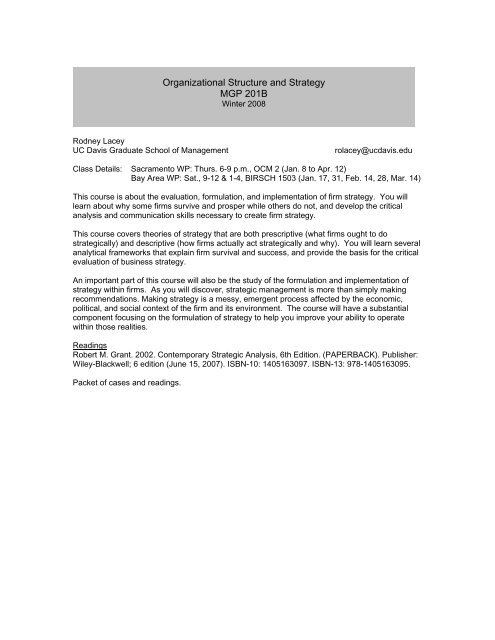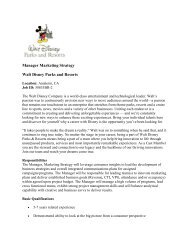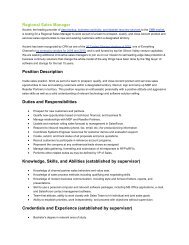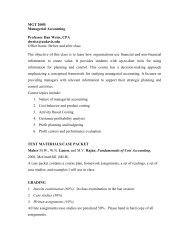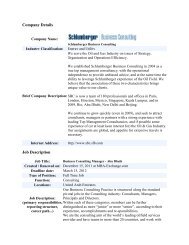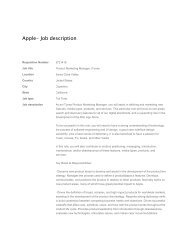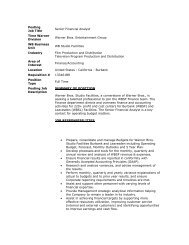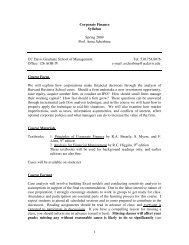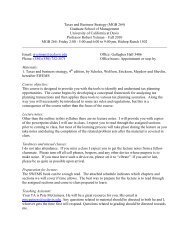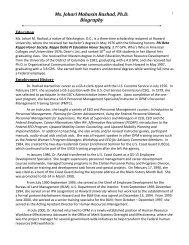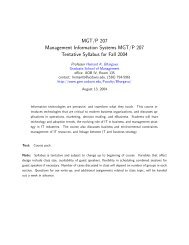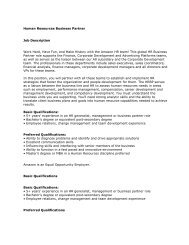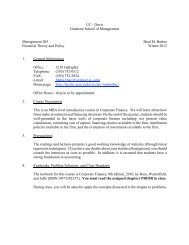Organizational Structure and Strategy MGP 201B - Students - UC ...
Organizational Structure and Strategy MGP 201B - Students - UC ...
Organizational Structure and Strategy MGP 201B - Students - UC ...
Create successful ePaper yourself
Turn your PDF publications into a flip-book with our unique Google optimized e-Paper software.
<strong>Organizational</strong> <strong>Structure</strong> <strong>and</strong> <strong>Strategy</strong><br />
<strong>MGP</strong> <strong>201B</strong><br />
Winter 2008<br />
Rodney Lacey<br />
<strong>UC</strong> Davis Graduate School of Management<br />
rolacey@ucdavis.edu<br />
Class Details: Sacramento WP: Thurs. 6-9 p.m., OCM 2 (Jan. 8 to Apr. 12)<br />
Bay Area WP: Sat., 9-12 & 1-4, BIRSCH 1503 (Jan. 17, 31, Feb. 14, 28, Mar. 14)<br />
This course is about the evaluation, formulation, <strong>and</strong> implementation of firm strategy. You will<br />
learn about why some firms survive <strong>and</strong> prosper while others do not, <strong>and</strong> develop the critical<br />
analysis <strong>and</strong> communication skills necessary to create firm strategy.<br />
This course covers theories of strategy that are both prescriptive (what firms ought to do<br />
strategically) <strong>and</strong> descriptive (how firms actually act strategically <strong>and</strong> why). You will learn several<br />
analytical frameworks that explain firm survival <strong>and</strong> success, <strong>and</strong> provide the basis for the critical<br />
evaluation of business strategy.<br />
An important part of this course will also be the study of the formulation <strong>and</strong> implementation of<br />
strategy within firms. As you will discover, strategic management is more than simply making<br />
recommendations. Making strategy is a messy, emergent process affected by the economic,<br />
political, <strong>and</strong> social context of the firm <strong>and</strong> its environment. The course will have a substantial<br />
component focusing on the formulation of strategy to help you improve your ability to operate<br />
within those realities.<br />
Readings<br />
Robert M. Grant. 2002. Contemporary Strategic Analysis, 6th Edition. (PAPERBACK). Publisher:<br />
Wiley-Blackwell; 6 edition (June 15, 2007). ISBN-10: 1405163097. ISBN-13: 978-1405163095.<br />
Packet of cases <strong>and</strong> readings.
2<br />
Overview<br />
# Topic Due Case Reading<br />
1 Introduction<br />
2<br />
Industry<br />
structure<br />
3 Competence<br />
4 <strong>Structure</strong><br />
5 Boundaries<br />
- Assign groups<br />
- Choose firm<br />
- Firm description<br />
- Group contract<br />
- Firm industry<br />
structure<br />
- Individual case<br />
- Firm<br />
competencies<br />
Firm fit between<br />
structure <strong>and</strong><br />
strategy<br />
6 External ties Individual case<br />
7<br />
8<br />
Global<br />
strategy<br />
Decision<br />
making<br />
N/A<br />
-Syllabus<br />
-Rosenzweig, “Halo Effect”<br />
-Grant, Ch 1&2<br />
Cola Wars Grant, Ch 3&4<br />
WalMart<br />
2003, 2005<br />
ISI A <strong>and</strong> B<br />
Re-do Cola<br />
Wars,<br />
WalMart<br />
Airbus<br />
(articles)<br />
- Walmart,<br />
2007<br />
- Wumart<br />
Late Shift<br />
(DVD)<br />
9 Mission Honda (A)<br />
10 Present Group project<br />
-Porter, “What is <strong>Strategy</strong>?”<br />
-Grant, Ch 5&7<br />
-Mintzberg, “<strong>Organizational</strong> design”<br />
-Grant, Ch 6<br />
-WalMart-Costco articles<br />
-Perrow, “Transaction cost”<br />
-Grant, Ch 8&13<br />
-Airbus articles<br />
-Grant, Ch 9&15<br />
-Biggart <strong>and</strong> Hamilton, “Limits of firmbased<br />
theory”<br />
-Bazerman, ”Decisions without blinders”<br />
-Jackall, “Moral mazes”<br />
-Carter, ”Late Shift” p. 1-30<br />
-Eccles <strong>and</strong> Norhia, “<strong>Strategy</strong> as a<br />
language game”<br />
Grant = Contemporary <strong>Strategy</strong> Analysis<br />
*Cases are all found in the reading packet for the course.<br />
Class 1 -- Introduction to strategy<br />
This class introduces the idea of strategy, what a class can offer, the major pitfalls in strategic<br />
thinking, <strong>and</strong> the format of the class.<br />
Rosenzweig, Phil. 2007. The Halo Effect. Chapters 8 <strong>and</strong> 10. Free Press: New York.<br />
Class 2 -- Industry structure<br />
This class focuses on the analysis of industry structure.<br />
Yoffie, David B. Cola wars continue: Coke <strong>and</strong> Pepsi in 2006. HBSP#9-706-447.<br />
Questions for Cola Wars case:<br />
• Why do Coke <strong>and</strong> Pepsi have independent bottlers that bottle other soft drinks? Why do the<br />
bottlers make lower margins?<br />
• What would be the obstacles to any other firm becoming a third player as large as Coke <strong>and</strong><br />
Pepsi? Why is there not room for three major soft drink firms?<br />
• How does this industry have an attractive structure for firms within the industry? How is it<br />
unattractive?
3<br />
• How has the current rivalry helped Coke <strong>and</strong> Pepsi’s profits? Hurt their bottom line?<br />
• What are the reasons for Coke’s lead over Pepsi in size? Will that persist in the future?<br />
Grant, Chapter 3<br />
• What is perfect competition, oligopoly, duopoly, <strong>and</strong> monopoly? How do they differ?<br />
• What are the five forces of Porter’s framework for industry analysis? What are examples of<br />
each these?<br />
• How are buyer <strong>and</strong> supplier power related?<br />
• How does (generally) increasing concentration in an industry affect buyer/supplier power?<br />
How does (generally) increasing concentration among buyers or suppliers for an industry<br />
affect the profitability of an industry?<br />
• What is an economy of scale? What is minimum efficient scale?<br />
• What are barriers to entry? Give examples of both nonmaterial <strong>and</strong> technological barriers to<br />
entry.<br />
• What is a switching cost? Give both a cash <strong>and</strong> non-cash example.<br />
• How does the threat of possible retaliation affect industry attractiveness? How does a firm<br />
establish a threat of retaliation to potential entrants?<br />
Grant, Chapter 4<br />
• What is an industry segment?<br />
• Explain, <strong>and</strong> give an example, of each of these dimensions for doing a segment analysis:<br />
o Product<br />
o Customers<br />
o Service (see Porter on variety, needs, access)<br />
• What is an industry group?<br />
o Explain, <strong>and</strong> give an example, of each of these dimensions for doing a group<br />
analysis:<br />
o Generic strategies (cost, differentiation, focus)<br />
• How are industry boundaries, segments, <strong>and</strong> strategic groups different? Are there clear<br />
indicators of where to draw the lines between them? If not, why not? When might you use a<br />
segment analysis rather than a group analysis?<br />
Class 3 -- Firm competencies<br />
This class investigates how a firm’s competencies can be a source of competitive advantage. A<br />
written case analysis of the Wal-Mart case, answering the questions below, is due.<br />
Porter, Michael. 1996. What is strategy? Harvard Business Review, November-December. HBR#<br />
96608.<br />
Ghemawat, Penjak, et. al. 2003. WalMart stores in 2003. HBSP# 9-704-430.<br />
Yoffie, David B. 2005. WalMart, 2005. HBSP# 9-705-460.<br />
Questions for Wal-Mart case analysis<br />
What, if any, of Wal-Mart’s capabilities are sources of competitive advantage in the discount<br />
retailing industry? Specifically, given the range of things that Wal-Mart does well, do any of these<br />
lead to increased bottom line performance that cannot be matched by competitors? Be specific in<br />
explaining why, <strong>and</strong> note that Wal-Mart has large, established, <strong>and</strong> competent competitors trying<br />
to match Wal-Mart’s performance.
4<br />
Porter, “What is <strong>Strategy</strong>?”<br />
• Porter makes an argument about uniqueness, tradeoffs, <strong>and</strong> sustainability of competitive<br />
advantage. Make sure you underst<strong>and</strong> each part:<br />
o Positioning by differentiation of activities --> success<br />
o <strong>Strategy</strong> is about choice of unique activities firm will do<br />
o Sustainable position requires trade-offs – why?<br />
o Fit between activities within the firm sustain position – why?<br />
Grant, Chapter 5<br />
• What are resources of a firm? Give three types, <strong>and</strong> examples of each.<br />
• What are capabilities? How are they related to resources?<br />
• What is benchmarking?<br />
• What are the three factors that determine the strategic value of a firm’s resources or<br />
capabilities?<br />
• What is meant by a sustainability of an advantage? What determines sustainability?<br />
Grant, Chapter 7<br />
• What is a competitive advantage?<br />
• Why are there not competitive advantages in perfectly competitive markets? Why not?<br />
• What makes an advantage sustainable or durable?<br />
• What are the factors that affect sustainability <strong>and</strong> durability?<br />
• Why is the adoption of one of the generic strategies (cost, focus, differentiation) a potential<br />
source of competitive advantage?<br />
Class 4 -- <strong>Organizational</strong> structure <strong>and</strong> strategy<br />
This class focuses on the interaction between organizational structure <strong>and</strong> strategy; how strategy<br />
requires the right organizational structures to succeed, <strong>and</strong> the existing organization structure<br />
sets the boundaries on the range of strategies for a firm.<br />
Mintzberg, Henry. 1981. <strong>Organizational</strong> design: fashion or fit? Harvard Business Review,<br />
January-February. HBR# 81106.<br />
Applegate, Lynda <strong>and</strong> Goldman, Kirk. 1997. Internet Securities, Inc.: Building a Business in<br />
Turbulent Times (A). HBSP # 9-398007<br />
Applegate, Lynda <strong>and</strong> Goldman, Kirk. 1997. Internet Securities, Inc.: Building a Business in<br />
Turbulent Times (B). HBSP# 9-803-013<br />
Question for ISI case<br />
How do you think ISI should build its organization for the future, <strong>and</strong> why? Make specific<br />
recommendations about how to change the organization <strong>and</strong> explain why each is important. This<br />
will require defining strategic goals for the firm, as the type of organization depends upon the<br />
strategy of the firm.<br />
Also remember that most organizing choices are tradeoffs; no form of organization can do all<br />
things (e.g., you can’t be both decentralized <strong>and</strong> centralized at the same time). So try to be clear<br />
about why you believe the tradeoffs you are choosing are superior.<br />
Mintzberg on structuring organizations <strong>and</strong> Grant, Chapter 6
5<br />
• Mintzberg defined six types of organizations: Simple structure, machine bureaucracy,<br />
professional bureaucracy, divisionalized firm, adhocracy, missionary. What are the defining<br />
characteristics of each?<br />
• How would you classify each of these organizations in terms of Mintzberg’s types of<br />
organizations: General Electric, Accenture (consulting firm), Goldman Sachs (investment<br />
bankers), Wal-Mart, U.S. Post Office, the University alumni association, a hot dog st<strong>and</strong>, <strong>and</strong><br />
your study group?<br />
• What kind of organization do you work for, or have worked for, given Mintzberg’s types of<br />
organizations? Given that type of organization, what does Mintzberg predict is the key part of<br />
the organization? Do you agree or disagree with that prediction for your firm?<br />
• What is a matrix organization, <strong>and</strong> what are an advantage <strong>and</strong> disadvantage of that form<br />
relative to a single hierarchy form of organization?<br />
• Define <strong>and</strong> give an example of each of the following types of coordination <strong>and</strong> control<br />
mechanisms: mutual adjustment, direct supervision, st<strong>and</strong>ardization of work processes,<br />
outputs, skills, <strong>and</strong> norms.<br />
Class 5 – Setting organizational boundaries: integration <strong>and</strong> differentiation<br />
This class focuses on how firms set their boundaries in terms of vertically up <strong>and</strong> down the value<br />
chain, <strong>and</strong> horizontally in terms of differentiation across multiple markets, places, etc. It<br />
examines the theory, the myths, <strong>and</strong> the realities of this process.<br />
Times, May 4, 2005.<br />
Greenhouse, Steven. 2005. How Costco became the Anti-Wal-Mart. New York Times, July 17,<br />
2005.<br />
Perrow, Charles. 1986. Complex organizations: A critical essay. “Transaction cost economics”, p.<br />
236-257. McGraw Hill: New York.<br />
Organization of Pepsi, Coca Cola, <strong>and</strong> WalMart<br />
• What advantages do these firms gain from their current arrangement of vertical integration?<br />
Is it the most efficient setting of boundaries? Why or why not?<br />
• Why are Pepsi <strong>and</strong> Coca Cola vertically integrated <strong>and</strong> differentiated in exactly the same<br />
ways? Is this good or bad for the firms?<br />
• How does WalMart controlup <strong>and</strong> down the value chain in ways that are similar to owning the<br />
businesses? Why do they choose not to integrate?<br />
Perrow on transaction costs, efficiency <strong>and</strong> effectiveness of firm boundaries<br />
• What is the theoretical basis for setting firm boundaries within economics? How do you know<br />
what will be the most efficient <strong>and</strong> effective arrangement?<br />
• What does Perrow say is the problem with the assumptions about the control given by<br />
markets <strong>and</strong> owning a firm within economic theory?<br />
• What are the alternative factors that influence the boundaries of a firm independent of<br />
efficiency? Are these rational forces, or irrational <strong>and</strong> should be removed?<br />
Grant, Chapter 8<br />
• What is a cost strategy? What are some of the sources of cost advantage?<br />
• What is the relationship (generally) between cost <strong>and</strong> market share?<br />
Grant, Chapter 13<br />
• What is vertical integration? Backward integration? Forward integration?
6<br />
• Vertical integration eliminates problems with buyer <strong>and</strong> supplier power. What, however, are<br />
the drawbacks to vertical integration? Why don’t firms do unlimited integration?<br />
• What are some examples of relationships between suppliers <strong>and</strong> buyers that are neither<br />
vertical integration nor anonymous exchange? What are their advantages? Drawbacks?<br />
Class 6 -- Inter-firm relations <strong>and</strong> cooperation<br />
This class examines cooperative relationship between firms. It investigates the strategic<br />
challenges to starting, maintaining, <strong>and</strong> ending, a collaborative or cooperative relationship with<br />
another firm.<br />
Hartley, Robert F. 2003. Management mistakes <strong>and</strong> successes. John Wiley & Sons. 7th ed.<br />
(Chapter 16, “Boeing Loses Dominance to Airbus” p. 222-233)<br />
Aris, Stephen. 2004. Close to the sun: How Airbus challenged America’s domination of the skies.<br />
New York: Agate. (p. 49-64; 195-208)<br />
Meyer-Larsen, Werner. 2000. Germany, Inc. New York: John Wiley. (p. 218-227)<br />
2004, “In Focus: Nöel Forgeard of Airbus”, July 19, CNN International.com.<br />
Branson, Richard. 2005. “Nöel Forgeard: Taking Airbus to a Higher Plane”. Time, April 18.<br />
Boxell, James, et al. 2005. “Cockpit Crisis”, Financial Times (London Edition), June 15,<br />
Comment <strong>and</strong> Analysis, p17.<br />
Done, Kevin <strong>and</strong> Spiegel, Peter. 2005. “EADS chiefs put focus on teamwork”, Financial Times<br />
(London Edition), Sept. 14, Companies International, p33.<br />
Clark, Nicola <strong>and</strong> Bennhold, Katrin. 2006. “For Airbus, turbulence at the helm”, The International<br />
Herald Tribune, June 16, News, p1.<br />
Clark, Nicola. 2006. “Co-chief of EADS refuses to step aside”, The International Herald Tribune,<br />
June 29, Finance, p14.<br />
Pae, Peter. 2006. “Two execs quit amid Airbus woes”, Los Angeles Times, July 3, p C1.<br />
Leggett, Theo. 2006. “Profile: Nöel Forgeard”, BBC News.com, July 2.<br />
L<strong>and</strong>ler, Mark. 2006. “Politics joins production as problem for Airbus”, New York Times, July 4, p<br />
C1.<br />
Matlack, Carol et al. 2006. “Wayward Airbus”, Business Week, October 23, p46.<br />
Question for Airbus case<br />
In perfectly <strong>and</strong> hilariously clear hindsight, how would you have organized Airbus to maximize its<br />
market effectiveness? Remember to consider the fact that different countries <strong>and</strong> firms had<br />
different capabilities, <strong>and</strong> that there are some political realities that cannot be avoided. For<br />
instance, you should not recommend that the French leave <strong>and</strong> sell it all to Germany – pride <strong>and</strong><br />
investments would preclude that.<br />
Grant, Chapter 9<br />
• What is a differentiation strategy?
7<br />
• How can a firm use a differentiation strategy when it is selling a commodity (i.e., a product<br />
that is identical in all performance aspects across producers)? (Hint: Think coffee.) What are<br />
the sources of differentiation? How does differentiation relate to customer perceptions?<br />
• How does a focus strategy differ from a differentiation strategy?<br />
Grant, Chapter 15<br />
• What is diversification? Related vs. nonrelated?<br />
• What are some of the motives for diversification by firms?<br />
• What are the potential competitive advantages from diversification?<br />
• What are the potential drawbacks to diversification in general? Specific to unrelated<br />
diversification?<br />
Class 7 -- Global strategy <strong>and</strong> firm organization<br />
This class demonstrates the range of possible, appropriate, <strong>and</strong> effective relationships between<br />
firms, ranging from arm’s length competition to close cooperation. The class also investigates the<br />
role of culture in strategy, <strong>and</strong> implementing strategy in a global context.<br />
Biggart, Nicole <strong>and</strong> Hamilton, Gary. 2004. “On the limits of a firm-based theory to explain<br />
business networks: The Western bias in neo-classical economics”. Chapter 7 in The <strong>Strategy</strong><br />
Reader, Susan Segal Horn (ed.), Second edition. Blackwell: Oxford.<br />
Yoffie, David B. <strong>and</strong> Slind, Michael. 2007. WalMart, 2007. HBSP# 9-707-517.<br />
Wang, Hong Iris, et al. 2007. Wumart stores: China’s response to Wal-Mart. HBSP# HKU635.<br />
Walmart, 2007 <strong>and</strong> Wumart cases<br />
• What new challenges is WalMart facing? How are challenges domestically affecting<br />
international operations <strong>and</strong> strategy?<br />
• What are the differences between the Wumart <strong>and</strong> WalMart strategy in China?<br />
• Compare the competencies of Wumart <strong>and</strong> WalMart in terms of efficiency <strong>and</strong> effectiveness<br />
of executing their strategy. What are the advantages <strong>and</strong> disadvantages for each?<br />
• What advantages over WalMart does Wumart gain from being a native firm?<br />
Biggart <strong>and</strong> Hamilton on institutions <strong>and</strong> economy<br />
In Biggart <strong>and</strong> Hamilton’s piece on the institutional basis of economies, they describe two<br />
different models for organizing an economy: the neoclassical model of the West, <strong>and</strong> the Asian<br />
models based on the business network. How do these models differ in terms of assumptions<br />
about:<br />
• the relationship between markets <strong>and</strong> social order<br />
• relationships between firms<br />
• <strong>and</strong> the costs <strong>and</strong> benefits to society of cooperation <strong>and</strong> competition.<br />
Class 8 -- Strategic decision making<br />
This class uses an in-class video of a real world strategic decision-making process to examine<br />
the social <strong>and</strong> political processes by which strategy is set <strong>and</strong> changed in large corporations.<br />
Bazerman, Max H. <strong>and</strong> Chugh, Dolly. 2006. Decisions without blinders. HBSP# R0601G<br />
Jackall, Robert. 1988. Moral Mazes: Bureaucracy <strong>and</strong> managerial work, HBR #83507
8<br />
Carter, Bill. 1994. The Late Shift: Letterman, Leno, <strong>and</strong> the network battle for the night. New York:<br />
Hyperion. (p. 1-32).<br />
Each student should bring a “cheat sheet” summary of the readings (as described below) to help<br />
guide viewing <strong>and</strong> our discussion.<br />
Preparation for Late Shift video case<br />
• Make a "cheat sheet" to remind you about Johnny Carson, David Letterman, Jay Leno, John<br />
Agoglia, Warren Littlefield, Bob Wright, Helen Kushnick, <strong>and</strong> Robert Morton – who are they,<br />
what is their job <strong>and</strong> how are they related in the structure of NBC?<br />
• Make a "cheat sheet" of the cognitive biases in the Bazerman article. It should be 1-2 page<br />
description that is a h<strong>and</strong>y reference for in-class exercises.<br />
• Make a "cheat sheet" of the political influences on decision making by executives from the<br />
Jackall reading. It should be 1-2 page description that is a h<strong>and</strong>y reference for in-class<br />
exercises.<br />
Class 9 -- Formulation <strong>and</strong> implementation of strategy<br />
The final case analysis for the course examines how strategy is formulated <strong>and</strong> evolves over time<br />
as it is implemented. It also examines how certain features of strategies make them more or less<br />
useful in adapting to changing conditions.<br />
Christiansen, Evelyn T. <strong>and</strong> Pascale, Richard Tanner. 1983. Honda (A). HBSP # 9-384-049.<br />
Eccles, Robert G. <strong>and</strong> Nohria, Nitin. 1992. ‘<strong>Strategy</strong> as a language game”, The <strong>Strategy</strong> Reader,<br />
Oxford: Blackwell: (Chapter 3, p 50-72) Excerpted from Beyond the hype: Rediscovering the<br />
essence of management. 1991. Harvard Business School Press.<br />
Honda Case<br />
What is the key lesson from the success of Honda to emulate? What is the key lesson about<br />
what to avoid in the example of the failure of Honda’s competitors?<br />
Class 10 -- Final group presentations<br />
Final group projects are due <strong>and</strong> there will be in class exercises <strong>and</strong> presentations.
9<br />
Course Requirements<br />
Group analyses of a firm's strategy (150 points): Everyone in class will be assigned a group that<br />
will analyze a single publicly traded firm over the course of the class. The group analyses will be<br />
an application of concepts to a real world example.<br />
The firm chosen by the group must be in a turnaround situation; it must be performing poorly<br />
when compared to the past. The strategic recommendations will be focused on making changes<br />
to improve performance. Specific format <strong>and</strong> requirements for the paper will be provided later in<br />
the course, but it will be a 10 to 12 page paper.<br />
Each group will present its strategy for their firm. Presentations will be between two groups, not<br />
before the whole class so there will be more chance for feedback. Each team will grade the other<br />
team during the presentation.<br />
The group project will affect your individual performance in two ways. First, you will be graded by<br />
your fellow group members on your effort <strong>and</strong> support of the group’s work; if you fail to be<br />
involved, you will be marked down on this portion of your grade. Second, if you are not involved in<br />
the analyses you will do poorly on the quiz on your company on the last day.<br />
Group analyses of a firm (50 points): For the first few weeks the group has to turn in a short<br />
written analysis that applies the concept of the previous week to their firm. The specifics of the<br />
assignments will be given later in class. All papers should follow the format for papers to help<br />
spare the eyes <strong>and</strong> improve the comments of the instructor.<br />
Class Participation (150 points): The class discussion is an important chance to learn so it is<br />
taken seriously. In class you can learn from your fellow students <strong>and</strong> practice the verbal skills of<br />
communication <strong>and</strong> dialogue.<br />
If you are absent from a class without an excuse (see policy below), your participation grade for<br />
the day will be zero. You need to participate actively. If you attend every class but are not<br />
engaged, you grade will be a “C”. An “A” or a “B” will be earned by activity in the classroom.<br />
Given that there are unexpected <strong>and</strong> uncontrollable events in everyone’s life, one class can be<br />
missed without any penalty to your grade (except the final group presentations).<br />
I will cold call (ask you to speak even if you have not volunteered). BE PREPARED FOR<br />
DISCUSSION EVERY CLASS.<br />
Listen to what other students are saying <strong>and</strong> respond to them directly.<br />
Be civil, courteous, <strong>and</strong> professional at all times. Disagreement is helpful when discussing a<br />
complex issue, but keep the conflict at a professional, not personal, level.<br />
Pay attention to the discussion. Part of participation is making an active audience for others.<br />
Participation grades will be reduced for unprofessional comments, lack of attention, or ignoring<br />
your fellow students’ comments.<br />
Individual case analyses (100 points): There are two individual case analyses due prior to the<br />
discussion of the case. The specific question for guiding that analysis is given for those weeks.<br />
The schedule indicates the week each paper is due. These papers should be 3-4 pages, double<br />
spaced, 12 point font (less than 1000 words).
10<br />
When writing, analyze or argue; do not repeat facts. Tell the audience something they don’t know<br />
even after they have done the readings. Either take a position about what should be done (i.e.,<br />
“SmithCo should not merge with another company because it will conflict with their corporate<br />
strategy of stable growth”) or give insightful analysis about the issue (“The power in this industry<br />
lies in the h<strong>and</strong>s of the suppliers because they are concentrated <strong>and</strong> their products are not<br />
substitutable”). In all cases, use facts to support your analysis <strong>and</strong> arguments.<br />
Final group project paper <strong>and</strong> presentation (150 points): The written portion of the final group<br />
project will have three representations of a firm strategy your group has developed for your firm.<br />
The first will be a one page or less direction document, the second is a graphical illustration of the<br />
strategy key points, <strong>and</strong> the third is a more detailed, 5 page description of the strategy. The<br />
project will require paring down the analyses of the entire class to the most important elements to<br />
guide the firm to act in an uncertain future.<br />
Grading Conversions: Grades will be on percentage scale of A+ (98% <strong>and</strong> above), A (93% <strong>and</strong><br />
above), A- (90% <strong>and</strong> above)....failing (64% <strong>and</strong> below).<br />
Course Policies<br />
Absences<br />
Attendance is necessary for participation, <strong>and</strong> participation is critical to your learning, so the class<br />
participation for any missed class is zero. There is no way to make-up participation, as it requires<br />
being in class. Please attend all classes.<br />
Given that there are extenuating circumstances in life, a student is allowed one (1) absence<br />
without penalty, with the exception of the final group project presentations. There will be no<br />
excused absences other than those defined by University policy. Absences that will not be<br />
excused include (but are not limited to) work schedules, business trips, interviews, airline or other<br />
travel delays due to anything other than severe <strong>and</strong> unpredictable conditions, <strong>and</strong> nonemergency<br />
events such as weddings, anniversaries, family vacations, etc.<br />
Late Class Assignments<br />
Papers are due at the beginning of class. Case paper analyses cannot be accepted late because<br />
a student would have the advantage of class discussion in doing their analysis. The final group<br />
project will also not be accepted late because there will be class discussion of those projects the<br />
final day of class as well that require the paper to be finished.<br />
If you have a foreseeable excused absence, any excused late papers must still be prepared<br />
BEFORE the class discussion of those topics to be turned in for a grade. In the rare cases where<br />
you have an excused <strong>and</strong> unforeseen absence, you will be required to do an independent,<br />
makeup assignment of equal difficulty.<br />
Late Final Group Projects <strong>and</strong> Missing the Final Class Day<br />
Any final group project turned in late will be immediately marked down. This will be dealt with on<br />
a case-by-case basis, but at the very least, any late project will be marked down a full letter<br />
grade.<br />
If anyone misses the discussion <strong>and</strong> presentation of final group projects, that person will receive<br />
a zero for that portion of the grade if it is an unexcused absence. In the rare case it is an excused<br />
absence, then the student will have to schedule a make-up time for a presentation to the<br />
instructor.<br />
Collaboration, Helping, Cheating, <strong>and</strong> Dishonesty
11<br />
One of the goals of this course is to encourage students to communicate with each other, <strong>and</strong> to<br />
help each other learn. Learning management is a process of communication, debate, <strong>and</strong><br />
argument, not a set of isolated exercises to be performed in private. The limitation to<br />
collaboration <strong>and</strong> helping, however, is when a student is no longer carrying the burden of<br />
learning. Some students are particularly adept at using the guise of collaboration <strong>and</strong> helping as<br />
a means to merely exploit others, <strong>and</strong> not do their own work. You may discuss case analyses, but<br />
you cannot copy from another’s analyses, or use their written analyses as a basis for your own<br />
paper. This subverts the meaning of education, <strong>and</strong> the potential value it has for improving our<br />
minds <strong>and</strong> our community discussions.<br />
Academic honesty is very important. The instructor will energetically investigate any failure to<br />
follow the academic honesty st<strong>and</strong>ards of the University.<br />
Particularly important is the issue of misrepresentation or plagiarism. In the era of Internet<br />
information it takes discipline to document one’s sources for written work. <strong>Students</strong> are reminded<br />
that they must be particularly scrupulous in this regard.<br />
Written Assignment Requirements <strong>and</strong> Format<br />
Papers are turned in as hardcopy; no emails.<br />
Use a 12-point font, DOUBLE SPACED, 1” margins all around. Always have page numbers.<br />
Staple papers only; no binding, folders, clips, or anything other than plain paper that will weigh<br />
down the instructor even further than usual.<br />
Always put your name on the front page. A title sheet is only necessary for the final paper (which<br />
will not count towards the page limits).<br />
Do not put your social security number on your paper or any other information that is confidential.<br />
Your papers are not treated as confidential information, so protect yourself.<br />
Do not exceed stated lengths; beyond those lengths will not be graded. Exhibits (graphs, tables,<br />
pictures, etc.) are not counted against the page length (within reason).<br />
Exhibits, or any numerical analyses, should always have a clear title explaining the exhibit, <strong>and</strong><br />
footnotes stating clearly any assumptions or additional data created for the exhibit. If the reader<br />
cannot replicate your exhibit from the notes, then it is not sufficient.<br />
Any cited references or other material that is not the author’s should be clearly cited in a<br />
bibliography that follows a widely accepted format. The bibliography does not count towards<br />
page limits.<br />
Accommodations for <strong>Students</strong> with Disabilities<br />
There will be accommodations made for students with disabilities, in accord with university<br />
guidelines.


